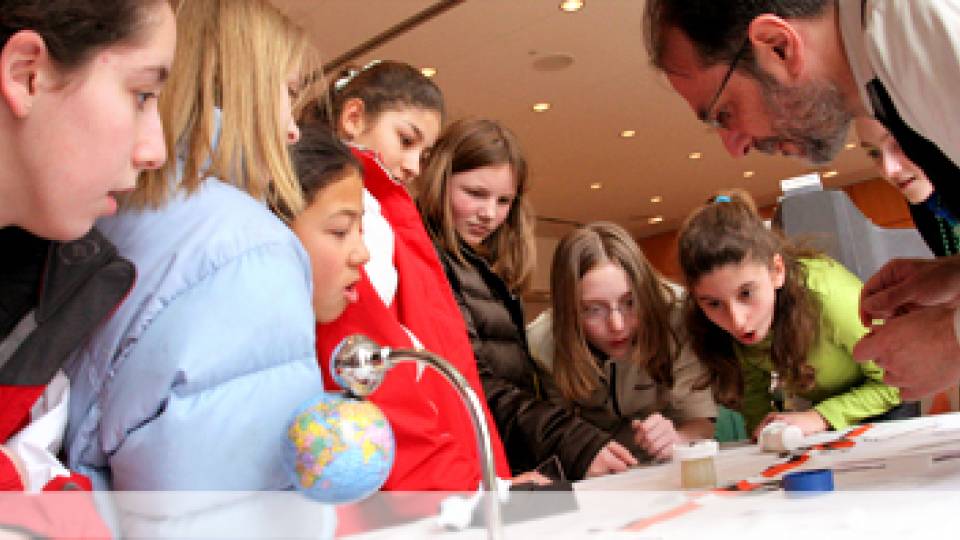
The door to the tiny room in Princeton's Icahn Laboratory closes, and darkness covers everyone inside: Ben Tiede, a dozen middle school students and one mouse.
"OK, what color is the Incredible Hulk?" asks Tiede, a graduate student in Princeton's molecular biology department.
"Green!" several voices respond. With that, Tiede shines a blue flashlight into the cage on the table, and the mouse lights up like a green neon sign.
"Its ears are green, its heart is green, everything is green except its fur," he says, once the gasps have subsided. "The reason is, they found a jellyfish that glows, and they took its gene and put it in the mouse. So now it glows in blue light, just like the jellyfish does in the blue light of the ocean."
"Wow, that's cool," one student says. "Does it help the mouse?" asks another.
"It doesn't help or hurt him, but it does help us to study him," Tiede says. "Mice are genetically about 95 percent similar to humans. We can transplant its cells into other mice, and when we study their bodies, it helps us identify what's happening inside them. That can often help us understand our own health too."
Tiede is one of more than 100 professors, students and volunteers who helped to show the fun side of research to nearly 1,000 students from 11 local middle schools at Princeton's annual Science and Engineering Expo on Thursday, March 22. Held at four locations across campus, the event aims to help maintain a sense of wonder among students at a time when interest in science can wane.

"We want to get their enthusiasm back," said Dan Steinberg, educational outreach director of the Princeton Institute for the Science and Technology of Materials (PRISM) and one of the expo's organizers. "Hopefully that will carry on into high school."
Through hands-on activities and demonstrations, the expo gives students a taste of most of the liveliest subjects in modern research -- physics, chemistry, molecular biology, materials science and engineering. The visiting teachers applauded the program for reinforcing the ideas they teach in their own classrooms, as well as showing middle schoolers where learning can take them.
"The expo has everything from bugs to rocks to explosives," said Rob Chesbro, a teacher at Montgomery Middle School. "It's great that my kids see that you can make a living doing science as a professor, but they also see a lot of older students doing demonstrations of their own work. Many of my students are career oriented, and when they see college students applying everything I'm teaching, it really inspires them."

Besides helping the students learn where else they can go with familiar subjects like biology and chemistry, the expo also revealed fields completely new to many of them.
"We're emphasizing engineering a bit more this year than in the past," Steinberg said. "Most middle school kids don't even know what engineering is, and they should."
The middle schoolers got plenty of opportunity to learn about engineering in Dillon Gymnasium this year. Though racquetballs may be a common sight in a gym, they don't normally shatter when they hit the ground -- unless they've recently been dunked in a bucket of liquid nitrogen.
That's just what chemical engineering professor Rick Register, the director of the Princeton Center for Complex Materials, and graduate students in his group did to introduce the students to the properties of polymers.
As the engineers explained to the curious onlookers, the cold liquid nitrogen caused the bonds between rubber molecules in the ball to become less flexible. And so, the balls shattered like glass when dropped to the floor.
Nearby, though, the balloons weren't popping -- not even when pierced with a wooden skewer as part of another demonstration by the Register group.
"It turns out that latex balloons are made of fibers," explained Sharon Gao, an eighth-grader from Grover Middle School in Princeton Junction. With a nod to the bright pink balloon kebab she held in her hands, she continued. "The fibers didn't break, they just stretched apart."
Fellow eighth-graders at Grover and budding videographers Marni Zahorsky and Shelby Miller documented these demonstrations, along with the others at nearly 30 booths throughout the gym, for their school's morning news show.

They had to raise the camera high to film the goings-on at the table of the Materials Research Society student group, their view blocked by crowds of students. There, sophomore Sharon Goswami and Jason Kawasaki were making ice cream using liquid nitrogen to cool the ingredients -- and handing out samples.
"Everyone likes ice cream," Goswami said as she stirred more chocolate syrup into a bowl filled with cream. "If this helps get them interested in science, it's great."
Jim Sturm, the William and Edna Macaleer Professor of Engineering and Applied Science and director of PRISM, concurred with Goswami.
"The reason that I and most of my colleagues ended up in science and engineering was because we thought it was fun," Sturm said. "The more we pique students' interest, the more likely they are to want to go into it."
The activities did a wonderful job of capturing student interest, said John McCann, a seventh-grade teacher at John Witherspoon Middle School in Princeton. "It's an enjoyable way to see science in motion," he said.
John Witherspoon middle schoolers Alexander Centeno and Jaelen Molina enjoyed the action, too, as they played croquet with remote-controlled robots built by students in the mechanical and aerospace engineering department.
"This was great," Alexander said. "I like this kind of science -- it's playing with robots!"










